Excursions
Excursions
Registration for the excursions is made in the conference registration form. If you are already registered for the conference, just log in to your registration and add a tour.
Tours #1a+1b are now joined
Updated schedule for tour 1a+1b:
- 13:55 Meet outside the lunch area. Walk to visit at the Water Power Lab at Gløshaugen Campus.
- 15:00 Walk to the Hydraulic research lab (15 mins)
- 15:15 Visit to the Hydraulic research lab (SP Andersen vei 5)
- 16:15 Tour ends for those who only participate in tour #1a
- 16:15 Bus from Hydraulic research lab (SP Andersen vei 5) to Øvre Leirfossen (15 mins)
- 16:30: Arrival at Øvre Leirfossen for guiding from Statkraft personell
- 17:15: Departure from Øvre Leirfossen area walk along the river, in the direction of the city, with some guided stops on the way.
- 19.00 Dinner at Lager 11
Tour #1a:
Excursion to hydroelectric labs at NTNU
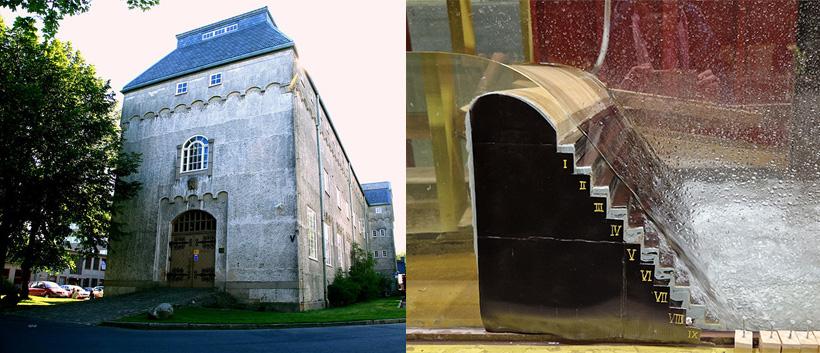
Water Power Lab at NTNU Photo: Øyvind Buljo/NTNU + Liv Randi Hultgreen/NTNU
Thursday June 15th you will get a guided tour at the Water Power laboratory and the Norwegian Hydrotechnical laboratory at the NTNU campus Gløshaugen. Here you will get insight into R&D on e.g.:
- Development, experiment and testing of hydropower turbines
- Facilities and test rigs for efficient design and maintenance of turbines
- Physical experiments on watercourses and hydropower plants
- Experimental, numerical and analytical studies relevant for sustainable hydropower
- R&D on design and solutions to e.g. mitigate supersaturation of turbine water
Excursion #1A information:
Note! view updated schedule for tours 1a+1b above.
- Excursion fee: included
- Departure: 13:55 from lunch area at the Elektro bld.
- Duration: 2–2.5 hrs.
- Guides: Researchers from the Dept. of Energy and Process Engineering and Dept. of Civil and Environmental Engineering (NTNU)
- Option to join excursion 1B: It is possible to join with excursion 1B for Nidelva river and optional dinner at own expence when excursion 1A ends. (1B lasts until 20:00 approx.)
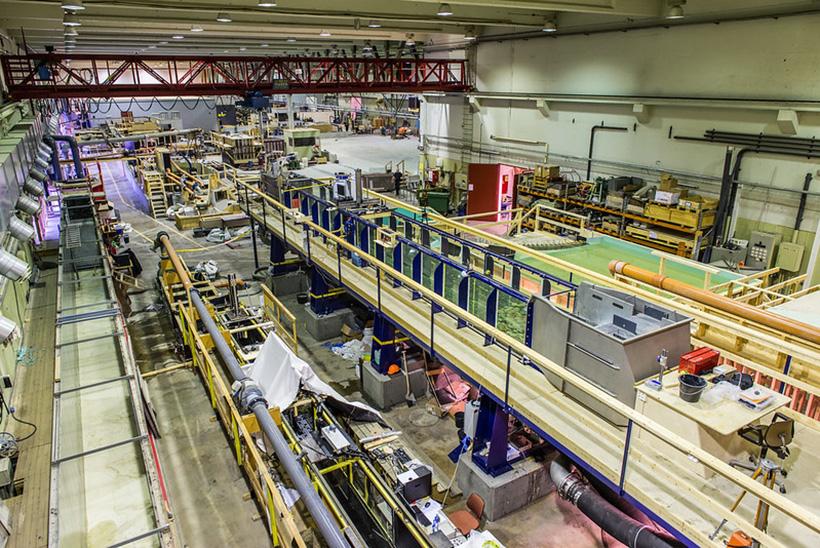
Norwegian Hydrotechnical Laboratory Photo: NTNU
Next we continue to get a guided tour at one of Europe's largest hydraulic laboratories, the Norwegian Hydrotechnical Laboratory (Vassdragslaboratoriet at NTNU – Valgrinda), where a large number of physical experiments on watercourses, dam safety, sediment management and hydropower plants have been and are carried out. The hydraulic laboratory is used for PhD research, for commercial projects and for education of MSc students. We will show some of the experimental setup, instruments and run demonstrations. Models in the lab have been important for optimizing design of hydropower plants, dam safety, flood defense structures, sediment problems, and also for environmental studies, for example layout of weirs, design of fish ladders and impacts of hydropeaking.
View video from the Norwegian Hydrotechnical Laboratory (YouTube)
Tour #1b:
Nidelva & Leirfossen
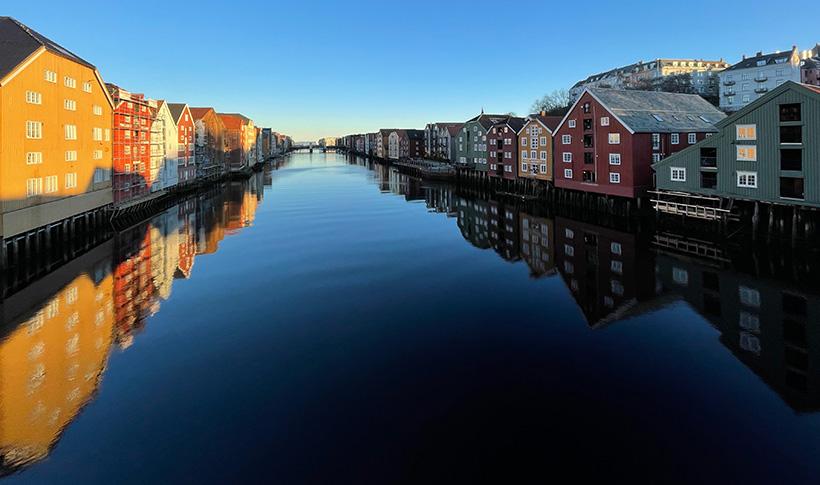
Nidelva river in Trondheim Photo: Kjell T. Næsgaard/NTNU
After lunch at Elektrobygget a bus will take your from the NTNU campus to Øvre Leirfoss in River Nidelva. From there you will get a guided walking tour downstream to visit the Nedre Leirfoss HPP (Operated by Statkraft), meet salmon fishermens, hear about projects by the local fishing association, R&D on river ecology and HP impacts like hydropeaking in Nidelva, meet representatives from Statkraft who will tell about how they operate and mitigate theirs HPP.
Excursion #1B information:
Note! view updated schedule for tours 1a+1b above.
- Excursion fee: included
- Departure: 13:55 from lunch area at the Elektro bld.
- Duration: 6 hrs. approx.
- Guides: Researchers from the Department of Civil and Environmental Engineering (NTNU)
- Dinner at Lager 11
We will walk downstream to the Austman local brewery, where you may buy dinner. You may also easily return downtown (by walking, local bus or take a taxi), or enjoy Austman.
Tour #2: Gaula and Orkla Rivers
Tour #2 has been cancelled due to low attendance.
Tour #3:
Overnight excursion to Surna & Driva National Salmon Rivers (in addition to Gaula and Orkla)
Excursion highlights:
- Visit four National Salmon Rivers: Orkla, Gaula, Surna & Driva
- HP mitigation and environmental design for salmon
- Relicensing process to modernise HP requirements
- Eflows, by-pass valves and ramping restrictions to ensure sustainable hydropeaking
- Mitigation of thermal alteration
- Salmon fishing, management, including measure and multi-pressures for the migratory fish species, including aquaculture
- WFD implementation and multi-pressures on riverine ecosystems
Excursion #3 information:
- Excursion fee: NOK 500,- + hotel (Note that hotel is not included with the excursion fee. See Hotel booking details in the registration form)
- Departure: 13:15 from NTNU campus
- Return:Friday, before 14:00 at Trondheim S railway station (e.g. connect with train or airport bus)
- Alternative dropoff: Friday, before 12:00 (noon) at Oppdal railway station
- for southbound train dep. 12:05 to Gardermoen/Oslo Airport, arrival at 16:41
- for northbound train dep. 13:01, arrival at Trondheim Airport at 15:52
- Included meals: Thursday: Boxed lunch, snacks & dinner Friday: Lunch buffet
- What to bring: warm jacket, shoes for outdoors and potentially rain gear
- Excursion leaders: Eyvor Aas & Jo H. Halleraker (both NEA)
Orkla
Orkla was developed for hydropower generation in the years from 1978 to 1985, with 5 large hydropower plants with a total capacity of 320 MW and 3 large artificial reservoirs. In addition, more than 9 small hydropower plants with total capacity 11.5 MW have been built during the last 20 years.
Orkla River facts:
- Catchment area: 3050 km2
- Length: 172 km
- Average flow: 75 m3/s
Surna
We continue to River Surna. The largest HP operator in Surna is the Trollheim HPP , operated by Statkraft since 1968 (130 MW, 851 GWh), which recently have been modernised through a relicensing process with several new mitigation measures. We will have dinner at a salmon lodge in River Surna, where we also will get a historical perspective of the importance of salmon fishing.
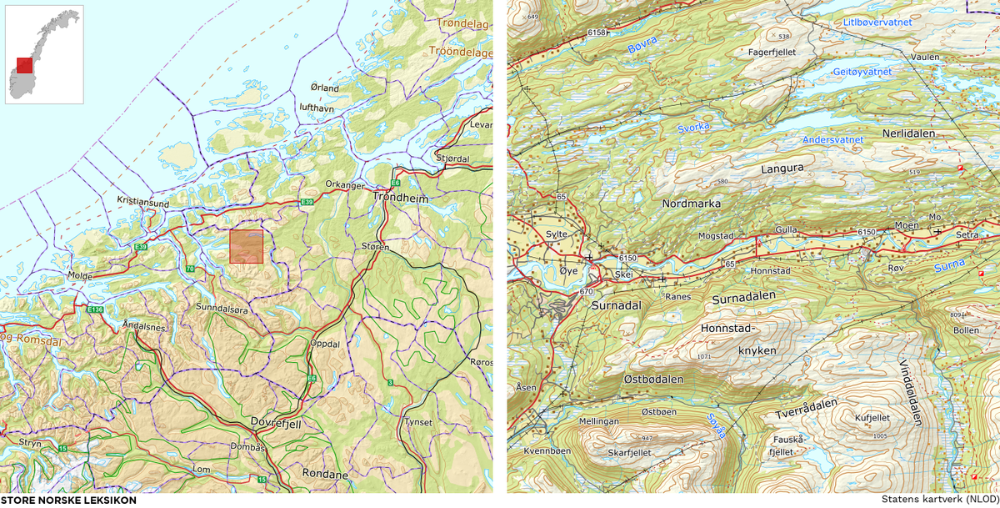
Surna river's location in Norway. Image: Store norske leksikon/Statens kartverk. Licence: NLOD
Surna River facts:
- Catchment area: -- km2
- Length: -- km
- Average flow: -- m3/s
Driva
Next morning we will a ferry towards "Drivaregionen" and Sunndalsøra, the outlet of River Driva. River Driva is known to be among the anadromous rivers in the world, where salmon historically can migrate highest above sea level (ca 580 m.a.s.l.).
Along this quite pristine National Salmon River, we will have the first stop at Snøvassmelan , where a manmade barrier to stop all up migrating salmon is constructed. This is part of a restoration strategy to save the salmon population in Driva from extinction, through a eradication strategy of the parasite gyrodactylus salaris (first detected here in1980). After the parasite have significantly reduced the salmon population, River Driva has gained attractiveness as a seatrout river. Water sports as river rafting and canyon expeditions are popular activities in the upper parts of Driva.
Further upstream we will visit the high head storage Driva HPP , operated by Trønder Energi since 1973. One of the first HPP in Norway with hydropeaking ramping restrictions, and by-pass valve to mitigate accidental turbine flow drop out.
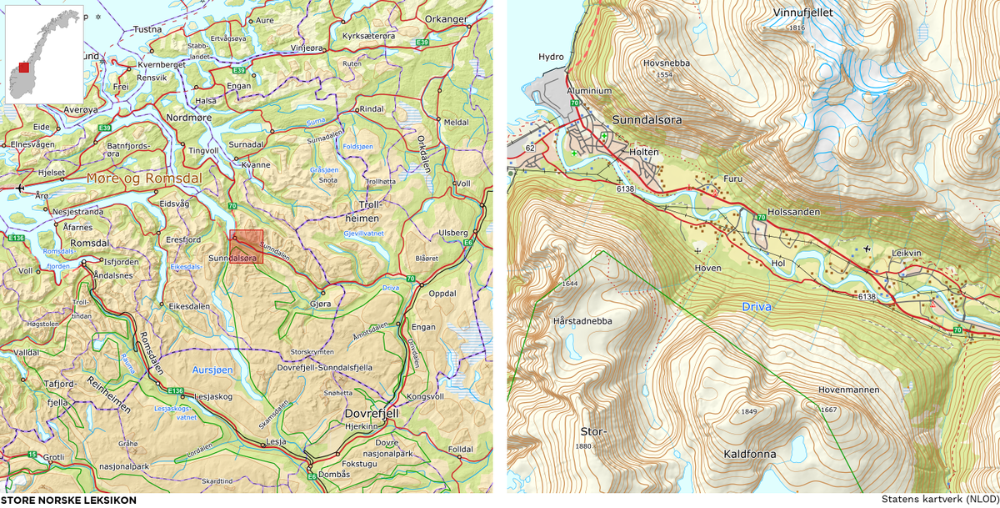
Driva river's location in Norway. Image: Store norske leksikon/Statens kartverk. Licence: NLOD
Driva River facts:
- Catchment area: -- km2
- Length: -- km
- Average flow: -- m3/s
Gaula
After lunch at Oppdal, we enter into the Gaula catchment, and will follow this large National Salmon River until its estuary in the fjord (Trondheimsfjorden). On our way we will inform about and visit river restoration projects, salmon fishing, riverine biodiversity, management regimes and multi pressures. A visit to Sokna HP , in the side tributary Lundesokna, operated by Trønder Energy since 1964 will be the last stop before the bus will return to Trondheim. Here we will hear about an ongoing relicensing process to modernise the environmental requirements.
Gaula River facts:
- Catchment area: 3658 km2
- Length: 145 km
- Average flow: 91 m3/s







